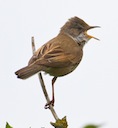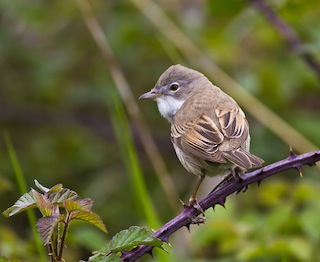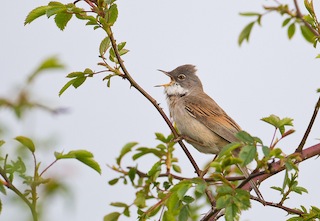 One of our summer visitors, you can spot Whitethroats into early autumn as they pass by on their way to Africa for the winter.
One of our summer visitors, you can spot Whitethroats into early autumn as they pass by on their way to Africa for the winter.
Photo: © Natural England/Allan Drewitt
Scientific name: Sylvia communis
Other common names: Common Whitethroat, Nettlecreeper
Cornish name: Barvgwynn
Conservation status: UK Birds of Conservation Concern, Amber
What to look for:
- Colouring and appearance: Male: grey head, pinkish-buff underparts, brown back, chestnut wings and, of course, its eponymous white throat. Female: also brown back and buff underparts, but a duller-coloured throat, and the head is brown not grey. The tail is fairly long.
- Size: Similar size to a Great Tit: wingspan 20cm, length 14 cm.
- Where: Summer visitor to much of the UK; found in relatively open but scrubby land and woodland edges, with bushes for nest-building.
- Call: Jolting, scratchy song.
- Similar species: Lesser Whitethroat, which is slightly smaller and has distinctive dark cheek feathers.
 Whitethroats are summer visitors to Europe and western Asia, flying northwards from their winter home south of the Sahara. They breed across much of our countryside in the UK, although they avoid upland areas and are not often seen in towns and cities. In duller weather Whitethroats are less easy to spot, as they dart about in the cover of shrubs and undergrowth, searching for insects to eat (and berries in the autumn). They have a habit of flicking their longish tail as they hop and fly about between branches. Bring on a sunny day, however, and they will perch themselves in the open, singing their scratchy song or scolding intruders to their territory.
Whitethroats are summer visitors to Europe and western Asia, flying northwards from their winter home south of the Sahara. They breed across much of our countryside in the UK, although they avoid upland areas and are not often seen in towns and cities. In duller weather Whitethroats are less easy to spot, as they dart about in the cover of shrubs and undergrowth, searching for insects to eat (and berries in the autumn). They have a habit of flicking their longish tail as they hop and fly about between branches. Bring on a sunny day, however, and they will perch themselves in the open, singing their scratchy song or scolding intruders to their territory.
 It is the male that builds the cup-shaped nest, constructing more than one from twigs and roots, wedged into shrubs. The female then selects one nest and lays a clutch of four to five eggs: both parents share incubation duties. Once hatched, the young fledge after about two weeks.
It is the male that builds the cup-shaped nest, constructing more than one from twigs and roots, wedged into shrubs. The female then selects one nest and lays a clutch of four to five eggs: both parents share incubation duties. Once hatched, the young fledge after about two weeks.
Whitethroats can be seen throughout the summer and until early autumn, after which they begin their return journey southwards.
Did you know…?
…Energy boost: the Whitethroat is one species of several songbirds that top up on flower nectar as a quick energy drink while on migration.
… A drought in the Whitethroat’s African overwintering grounds in 1968 caused significant mortality, followed by a 90% reduction in the number breeding in the UK the following summer. Numbers here have increased since but have not reached the pre-1969 level: this is the reason for this species’ Amber status in the UK.
More information and references:
Svensson, L., Mullarney, K., Zetterstrom, D.,1986. Collins Bird Guide, second edition (translated by Christie, D., Svensson, L.). HarperCollins, London.
Published: August 2014
Author: Amanda Scott
Photos: © Natural England/Allan Drewitt
